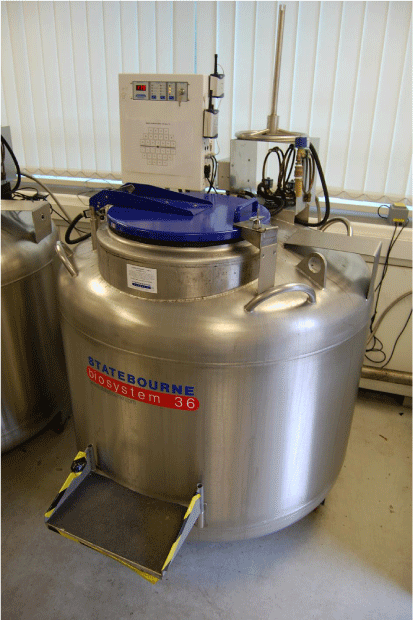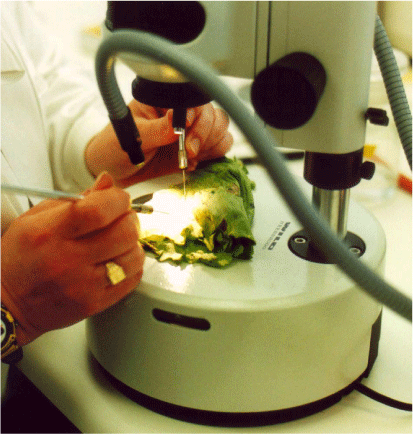CABI’s 100 years in identifying and combating emerging fungal diseases in response to climate change
David Smith A * , Jonathan Casey B , Matthew J. Ryan A , Lisa Offord A , Alexis Rendell-Dunn B and Rob Reeder AA CAB International, Bakeham Lane, Egham, Surrey TW20 9TY, UK.
B CAB International, Noseworthy Road, Wallingford, Oxfordshire OX10 8DE, UK.

David Smith is Director Biological Resources at CAB International. His research interests are in the conservation and sustainable use of microorganisms in agriculture and the environment. |

Jonathan Casey is Climate Change Manager at CAB International. His research focus is on climate resilience and adaptation in smallholder farming sectors and resilient landscape management, and the uptake of climate-smart agriculture. |

Matthew J. Ryan is a microbiologist and research lead at CAB International. His specific interests are in pure and applied mycology, biodeterioration, natural product research and the cryopreservation of fungi. |

Lisa Offord is a bacteria and yeast specialist working in CAB International, Plantwise Diagnostic and Advisory Service, writing reports based on sequencing analysis for CABI’s Identification service. |

Alexis Rendell-Dunn is Head of Content Management, Plant and Environmental Sciences at CAB International with experience in database publishing and particular interests in horticulture, postharvest and commodities. |

Rob Reeder is a plant pathologist and team leader at CAB International providing diagnostic and technical support for plant health issues. He has a background in research on the biological control of tropical weeds with fungi and now focused on the diagnosis and management of tropical pests and diseases and the strengthening of plant health services in developing countries. |
Microbiology Australia 43(4) 160-164 https://doi.org/10.1071/MA22054
Submitted: 2 October 2022 Accepted: 4 November 2022 Published: 1 December 2022
© 2022 The Author(s) (or their employer(s)). Published by CSIRO Publishing on behalf of the ASM. This is an open access article distributed under the Creative Commons Attribution-NonCommercial-NoDerivatives 4.0 International License (CC BY-NC-ND)
Abstract
CABI has been involved in identifying and combatting emerging fungal disease of plants for over 100 years and in doing so has built a wealth of resources to support farmers and practitioners in reducing crop loss. CABI does not achieve this alone – being an international, inter-governmental, not-for-profit organisation, its 49 Member Countries guide and influence its work, which a network of global partners helps deliver. This work is becoming more relevant in light of increasing threats from climate change, invasive species and pathogens becoming resistant to biocides. Here, we focus on how climate change is influencing disease occurrence and how CABI’s work and resources can help in the battle to manage emerging and spreading diseases. CABI’s culture collection maintains living and active strains of pathogens and biocontrol agents for use as reference materials, its diagnostic advisory service and network of partners helps identify problems and provide solutions and CABI’s information resources underpin it all.
Keywords: bacteria, climate change, culture collection, diagnostics, distribution, emerging disease, fungi, information resource, plant pathogen.
Introduction
CABI has worked in agriculture and the environment for over 100 years. The establishment of the Imperial Bureau of Mycology in 1920 laid the foundation of CABI’s expertise in mycology that continues to this day.1 Throughout this period specimens were received for identification from all over the world and CABI’s living culture collection has amassed 30 000 strains of fungi and bacteria including 5000 plant pathogens and other microorganisms. An understanding of microbes and microbial communities is essential for improving crop yields and facilitating interventions, such as biocontrol of pests, diseases, and invasive species. In parallel to the scientific work, the CABI information resources were built to support the science and fieldwork to increase the reach, application, and understanding of the science worldwide. In carrying out its work, CABI has observed an impact on emerging disease due to climate change and implemented programmes to help farmers adapt to its impact.2
CABI collection
The CABI living collection includes isolates from plant disease diagnostic work, the many global projects it has been involved in and deposits from researchers, particularly strains cited in scientific literature. It now comprises 28 000 strains of fungi and 2000 strains of bacteria from 142 countries. Initially, isolates were sub-cultured, but from the 1960s long-term optimised storage by freeze drying and cryopreservation was introduced3 (Fig. 1). These strains provide reference points for identification and research and strain details can be found at: https://www.cabi.org/services/microbial-services/culture-collection-microorganism-supply/grc/. Because the strains have been deposited over a period of nearly 100 years, CABI’s holdings present a unique opportunity to study the evolution of pathogens in response to climate change4 and potentially provide mechanisms to mitigate against it (https://www.cabi.org/about-cabi/climate-change/).

|
Diagnostic and Advisory Service (DAS)
CABI’s Diagnostic and Advisory Service (DAS) provides diagnostic advice on pests and diseases on crops (Fig. 2). DAS receives enquiries from all over the world, although most originate from CABI’s member countries. The diagnosis is based on symptoms and microscopic examination of the isolated pathogen with confirmation through molecular techniques. The standard molecular methods rely on rDNA sequencing (typically ITS sequences for fungi and 16S rRNA gene sequences for bacteria) and comparison to in-house and public databases such as the European Nucleotide Archive. In addition to sequencing, techniques such as MALDI-TOF (matrix-assisted laser desorption ionisation – time of flight analysis) are used. Historically, CABI has focussed on fungal and bacterial pathogens, nematodes and some insect groups with suspected viruses or phytoplasmas being sent to collaborators for analysis. Recent new country reports of pests and diseases confirmed by the DAS laboratory include: Moniliophthora roreri causing frosty pod rot on cocoa in Jamaica5 and the apple snail, Pomacea canaliculate, which was found in the waterways of Kenya.6 Fall Armyworm (Spodoptera frugiperda), indigenous throughout the Americas, has recently appeared in Africa and Asia and CABI with its partners have been instrumental in monitoring and combatting this pest.7–10 The caterpillars of this moth feed on leaves, stems and reproductive parts of more than 100 plant species, causing major damage to crops11 (also see https://blog.plantwise.org/2019/06/20/plantwise-helps-with-managing-the-invasive-fall-armyworm-in-vietnam/).

|
CABI’s projects of relevance to emerging diseases
CABI collaborates with its member countries, donors and partners to combat major identified and emerging threats to agriculture and the environment, and to improve access to scientific information (https://www.cabi.org/what-we-do/cabi-projects). CABI is currently (at 20 August 2022) working on 57 crop health initiatives, the majority in Africa and Asia. In sub-Saharan Africa, CABI in partnership with the UK space agency and Assimila Ltd, have developed the Pest Risk Information SErvice (PRISE) (https://www.cabi.org/projects/prise-a-pest-risk-information-service/), using earth observation environmental data and models on pest life cycles to create early warning alerts and advice on timely application of pest control products.
CABI’s global PlantwisePlus programme works closely with national agricultural advisory services, to establish a global network of plant clinics, run by trained ‘plant doctors’. Rural plant clinics, staffed by agricultural advisors trained through PlantwisePlus, receive diseased samples and provide a timely diagnosis and appropriate remedial advice. The programme has been introduced to 34 countries in Africa, Asia and the Americas, presented over 5000 plant clinics, trained over 13 200 plant doctors and reached over 54 million small holder farmers. Recommendations to farmers have resulted in halving the use of restricted chemicals, increasing yields by more than 20% and over 1.5 million farmers have improved food security (https://www.plantwise.org/impact/plantwise/). The programme is underpinned by the Plantwise Knowledge Bank (https://www.plantwise.org/knowledgebank/) and together these strengthen national plant health systems.
It is estimated that up to 40% of crop yields are lost to pests and diseases.12 Data collected, validated, analysed, and disseminated through the Global Burden of Crop Loss project has been used to prioritise research and policy in plant health, enabling better predictions of the impact of emerging diseases (https://www.cabi.org/projects/global-burden-of-crop-loss/).
Climate change impacts on fungal disease risks
CABI’s work in its collection, diagnostics, consultations with member countries, projects in the field and compilation of scientific literature and field reports has seen growing evidence that climate change is increasing the threat of emerging diseases (also see FAO 2021, https://www.fao.org/news/story/en/item/1402920/icode/). A global average increase of 2°C, is estimated to result in increased crop losses, due to pests and disease of up to 46% (59 million tonnes) for wheat, 19% (92 million tonnes) for rice and 31% (62 million tonnes) for maize.13
Global warming will also likely affect the epidemiological characteristics and spread of fungal diseases by creating novel favourable climatic niches and placing new areas at risk of pest and disease attacks.12 According to Juroszek and von Tiedemann,14 60% of the fungal pathogens of agricultural and horticultural crops would pose increased production risks under future climate change scenarios. Other research has also shown that increased levels of atmospheric CO2 causes increases in fungal biomass of pathogens that gives rise to crop disease.15 The combination of both temperature change and elevated CO2 levels has been shown to increase the disease risk from mycotoxins in rocket, cabbage and cauliflower crops.16 Combating this will necessitate increased surveillance tools and improved rapid response mechanisms.
Recent research has identified that fungi and oomycetes are adapting and spreading rapidly around the world, partly in response to climate change.17 Climate change models predict higher water vapour concentrations and windy conditions that favour fungal disease development and dispersal.18,19 Emerging areas of research aim to integrate microclimate models into pest risk analysis tools, using enhanced earth observation technologies to improve modelling approaches.20 This work has highlighted that in some cases there is a ‘decoupling’ between some microclimates and the macroclimate, highlighting the need for more localised risk analysis.
Through its Horizon Scanning tool and approaches (https://www.cabi.org/publishing-products/horizon-scanning-tool/), CABI has undertaken climate niche analyses of several critical pests, diseases, and invasive plants to assess the potential new areas of risk. As part of the Pest Risk Analysis tool and process, CABI has integrated climate change factors as a key variable in analysing the severity of high-priority invasive pests and diseases (https://www.cabi.org/publishing-products/pest-risk-analysis-tool/).
CABI’s information resources providing data to combat emerging diseases
CABI publishes a number of information resources used by students, researchers, practitioners and plant health advisors. CAB Abstracts (https://www.cabi.org/publishing-products/cab-abstracts/), covers all aspects of research published since 1973 on plant diseases including the biology, genetics, taxonomy, transmission and distribution of plant pathogens; monitoring, forecasting and control of plant diseases; and new disease reports. Pre-1973 research is covered in CAB Abstracts Archive (https://www.cabi.org/publishing-products/cab-abstracts-archive/). Records linking the spread of fungal diseases with climate change can be traced back to the 1960s.21 The spread of diseases to new hosts and new regions can be tracked over time with over 17 000 records of new disease reports from scientific journals, bulletins, conferences and grey literature published since 1973.
The Distribution Maps of Plant Diseases (https://cabidigitallibrary.org/journal/dmpd), published since 1942, are compiled in association with EPPO (European and Mediterranean Plant Protection Organization; https://www.eppo.int/). Priority is given to mapping species with recent reports of spread or species newly proposed for phytosanitary categorisation. Species recently mapped include Phyllachora maydis, emerging in the USA, is the only species of Phyllachora reported on maize and Magnaporthe oryzae pathotype Triticum pathotype (wheat blast), which threatens global wheat production.
Comprehensive datasheets on emerging diseases are available in CABI’s encyclopaedic electronic compendium, the CABI Compendium (www.cabidigitallibrary.org/cabicompendium), with over 3500 detailed datasheets on crop pests, diseases, weeds, invasive plants and natural enemies. Datasheets on emerging diseases such as Phyllachora maydis include information on taxonomy, distribution, transmission, habitat, hosts, symptoms, biology, ecology, diagnosis, economic impact, and prevention and control, supported by images and maps. The data behind the maps and tables can be interrogated and bespoke reports produced. Tools such as the Horizon Scanning Tool (https://www.cabi.org/horizonscanningtool) and the Pest Risk Analysis tool (https://www.cabi.org/PRA-Tool/about) use data in the CABI Compendium to facilitate the identification of emerging threats across borders and complete risk assessments for diseases associated with commodity pathways.
Other CABI information resources contributing to the field include the Descriptions of Fungi and Bacteria (https://cabidigitallibrary.org/journal/dfb), which provide diagnostic descriptions, illustrations and information on over 1700 plant pathogenic fungal and bacterial taxa and the CABI BioProtection Portal (https://bioprotectionportal.com/), a free web-based tool allowing users to discover information about registered biopesticide products around the world.
Discussion and conclusions
The wealth of information on plant health generated from decades of research provides insight and tools to predict and combat emerging pest and disease threats that are exacerbated by climate change. There is a need for more investment in plant health monitoring, not just to measure presence or absence, but to monitor spatial distribution and temporal changes for improved epidemiological intelligence.22 Improved prediction and monitoring will enable rapid responses to new and emerging diseases, particularly in low- and middle-income countries for which the impacts can be particularly severe.23 The CABI-led PRISE service provides forecasts to farmers in sub-Saharan Africa of pest outbreaks, using a combination of earth observation technology, real-time field observations, and modelling of plant–pest lifecycles. PRISE has delivered pest alerts in Kenya, Ghana, Zambia and Malawi to over 1.8 million farmers since it began in 2017. CABI’s networks of global partners and international programmes such as PlantwisePlus also provide valuable insights into the emerging diseases that small holder farmers are facing in Africa, Asia and South America. Problems remain in reporting, publishing, and communicating of plant disease outbreaks and new records for plant health regulation. The samples received by the DAS laboratory through its plant click networks are helping countries to identify pests and diseases earlier leading more timely interventions. New detection technologies, for example remote sensing,24 are being developed, and could potentially feed into more cost-effective and widespread monitoring.
It is clear that climate change exacerbates problems and broadens the scope and range of plant pests and invasive species by enabling organisms to grow in environments from which they have normally been excluded. Predictive models and early warning systems are needed if we are to combat such problems, for which CABI’s information resources and dissemination systems can play a critical role.
Data availability
Data sharing is not applicable as no new data were generated or analysed during this study.
Conflicts of interest
The authors declare no conflicts of interest.
Declaration of funding
CABI is an international intergovernmental organisation, and we gratefully acknowledge the core financial support from our member countries (and lead agencies) including the United Kingdom (Department for International Development), China (Chinese Ministry of Agriculture), Australia (Australian Centre for International Agricultural Research), Canada (Agriculture and Agri-Food Canada), The Netherlands (Directorate-General for International Cooperation), and Switzerland (Swiss Agency for Development and Cooperation).
References
[1] Blight D, Ibbotson R (2011) CABI: a Century of Scientific Endeavour. CAB International, Wallingford, UK, ISBN 978-1-84593-873-4. https://www.cabi.org/wp-content/uploads/100-Year-Book.pdf[2] CABI (2022) Climate change and biodiversity. Helping farmers adapt to climate change. https://www.cabi.org/about‐cabi/climate‐change/
[3] Smith D et al. (2022) Contribution of CABI to sustainable futures through the utilization of fungal genetic resources. In Importance of microbiology teaching and microbial resource management for sustainable futures. (Kurtboke I et al., eds). pp. 230–273. WFCC Elsevier. https://www.elsevier.com/books/importance-of-microbiology-teaching-and-microbial-resource-management-for-sustainable-futures/kurtboke/978-0-12-818272-7
[4] Peck, LD et al.. (2021) Historical genomics reveals the evolutionary mechanisms behind multiple outbreaks of the host-specific coffee wilt pathogen Fusarium xylarioides. BMC Genom 22, 404.
| Historical genomics reveals the evolutionary mechanisms behind multiple outbreaks of the host-specific coffee wilt pathogen Fusarium xylarioides.Crossref | GoogleScholarGoogle Scholar |
[5] Johnson, ES et al.. (2017) First report of Moniliophthora roreri causing frosty pod rot on Theobroma cacao in Jamaica. New Dis Rep 36, 2.
| First report of Moniliophthora roreri causing frosty pod rot on Theobroma cacao in Jamaica.Crossref | GoogleScholarGoogle Scholar |
[6] Buddie, AG et al.. (2022) First report of the invasive snail Pomacea canaliculata in Kenya. CABI Agric Biosci 2, 11.
| First report of the invasive snail Pomacea canaliculata in Kenya.Crossref | GoogleScholarGoogle Scholar |
[7] Uzayisenga, B et al.. (2018) First record of the fall armyworm, Spodoptera frugiperda (J.E. Smith, 1797) (Lepidoptera: Noctuidae), in Rwanda. Afr Entomol 26, 244–246.
| First record of the fall armyworm, Spodoptera frugiperda (J.E. Smith, 1797) (Lepidoptera: Noctuidae), in Rwanda.Crossref | GoogleScholarGoogle Scholar |
[8] Agboyi, LK et al.. (2020) Parasitoid complex of fall armyworm, Spodoptera frugiperda, in Ghana and Benin. Insects 11, 68.
| Parasitoid complex of fall armyworm, Spodoptera frugiperda, in Ghana and Benin.Crossref | GoogleScholarGoogle Scholar |
[9] Durocher-Granger, L et al.. (2021) Factors influencing the occurrence of fall armyworm parasitoids in Zambia. J Pest Sci 94, 1133–1146.
| Factors influencing the occurrence of fall armyworm parasitoids in Zambia.Crossref | GoogleScholarGoogle Scholar |
[10] Kenis, M et al.. (2019) Telenomus remus, a candidate parasitoid for the biological control of Spodoptera frugiperda in Africa, is already present on the continent. Insects 10, 92.
| Telenomus remus, a candidate parasitoid for the biological control of Spodoptera frugiperda in Africa, is already present on the continent.Crossref | GoogleScholarGoogle Scholar |
[11] Cock, MJW et al.. (2017) Molecular methods to detect Spodoptera frugiperda in Ghana, and implications for monitoring the spread of invasive species in developing countries. Sci Rep 7, 4103.
| Molecular methods to detect Spodoptera frugiperda in Ghana, and implications for monitoring the spread of invasive species in developing countries.Crossref | GoogleScholarGoogle Scholar |
[12] IPPC (2021) Plant health and climate change. FAO, Rome. http://www.fao.org/3/cb3764en/cb3764en.pdf
[13] Deutsch, CA et al.. (2018) Increase in crop losses to insect pests in a warming climate. Science 361, 916–919.
| Increase in crop losses to insect pests in a warming climate.Crossref | GoogleScholarGoogle Scholar |
[14] Juroszek, P and von Tiedemann, A (2015) Linking plant disease models to climate change scenarios to project future risks of crop diseases: a review. J Plant Dis Prot 122, 3–15.
| Linking plant disease models to climate change scenarios to project future risks of crop diseases: a review.Crossref | GoogleScholarGoogle Scholar |
[15] Kybartaitė, J et al.. (2020) Plants and fungal pathogens under climate change, a review. Optimization of Ornamental and Garden Plant Assortment, Technologies and Environment 11, 37–45.
[16] Siciliano, I et al.. (2017) Effect of different temperatures and CO2 levels on Alternaria toxins produced on cultivated rocket, cabbage and cauliflower. World Mycotoxin J 10, 63–71.
| Effect of different temperatures and CO2 levels on Alternaria toxins produced on cultivated rocket, cabbage and cauliflower.Crossref | GoogleScholarGoogle Scholar |
[17] Chaloner, TM et al.. (2020) Geometry and evolution of the ecological niche in plant-associated microbes. Nat Commun 11, 2955.
| Geometry and evolution of the ecological niche in plant-associated microbes.Crossref | GoogleScholarGoogle Scholar |
[18] Petzoldt C, Seaman A (2006) Climate change effects on insects and pathogens. Climate Change and Agriculture: Promoting Practical and Profitable Responses. http://www.climateandfarming.org/pdfs/FactSheets/III.2Insects.Pathogens.pdf
[19] Karthik S, et al. (2021) Climate change and its potential impacts on insect-plant interactions. In The Nature, Causes, Effects and Mitigation of Climate Change on the Environment (Harris SA, ed.). Intech Open.
| Crossref |
[20] Hemming D (2021) Integrating microclimate models into pest risk analysis. IPRRG Seminar Series 7. https://www.youtube.com/watch?v=2uNfVny-0VU (accessed 28 March 2022)
[21] FAO (1960) Proceedings of the Fifth World Forestry Congress. FAO, Rome. https://www.fao.org/3/X5397E/X5397E02.htm
[22] Ristaino, JB et al.. (2021) The persistent threat of emerging plant disease pandemics to global food security. Proc Natl Acad Sci U S A 118, e2022239118.
| The persistent threat of emerging plant disease pandemics to global food security.Crossref | GoogleScholarGoogle Scholar |
[23] Carvajal-Yepes, M et al.. (2019) A global surveillance system for crop diseases. Science 364, 1237–1239.
| A global surveillance system for crop diseases.Crossref | GoogleScholarGoogle Scholar |
[24] Zarco-Tejada, PJ et al.. (2018) Previsual symptoms of Xylella fastidiosa infection revealed in spectral plant-trait alterations. Nat Plants 4, 432–439.
| Previsual symptoms of Xylella fastidiosa infection revealed in spectral plant-trait alterations.Crossref | GoogleScholarGoogle Scholar |


